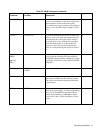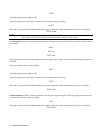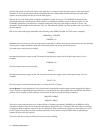Operating Instructions
59
Reset. Reset restores the power supply output if it has been disabled by OVP, foldback, or remote inhibit. The output returns
to the present voltage and current settings; the values may be changed while the output is disabled. The power supply is
reset with the command:
RST
Note that if the condition which caused OVP or foldback remains, the power supply output will be disabled again after reset.
If a condition which tripped the INH input (set the RI bit true (1)) remains after a RST command is issued, the supply will
not be re-enabled. The condition which tripped the INH input must be removed and the RI bit must become false before the
supply can be returned to its previous settings. If the power supply output is disabled repeatedly, check that the OVP setting
and delay time are appropriate for the application.
Hold and Trigger. The power supply contains first-rank and second-rank storage registers for values of voltage setting,
current setting, foldback, and mask. The operating values are stored in the second rank, but the first rank can receive and
hold different values for later implementation. With hold turned on, values in first rank are moved to second rank only upon
receipt of a trigger or device trigger command.
This feature allows synchronization of multiple instruments on the GP-IB, and also ensures that new values are implemented
at the same time within a single instrument. With hold turned off, values are loaded into both first and second rank when
received.
Hold is turned on and off using these codes:
HOLD OFF or HOLD 0
HOLD ON or HOLD 1
The state of the hold on/off function may be read by sending:
HOLD?
and addressing the power supply to talk. The response from the power supply is in this format:
HOLD 0 or HOLD 1
in which 0 indicates that hold is turned off, and 1 indicates that hold is turned on.
Values that are held in first rank can be shifted to second rank (operating values) using either of these commands:
TRG or T
The device trigger interface command will also shift data from first rank to second rank.
Voltage and current values are compared to soft limits before being loaded into either first or second rank, and new soft
limits are compared to values already programmed in both first and second rank. Any discrepancy between first and second
rank voltage or current settings and voltage or current soft limits will result in an error condition.
The power supply has been designed to allow it to enforce sequential device command processing, which means that a
second instrument on the GP-IB will not begin to receive commands until the power supply has finished processing its
commands. The power supply can accept data much faster than it can process data. Therefore, if a second instrument had
less data to process than the first had, the second instrument could start changing its output before the first instrument output
started changing, even though the first instrument may have accepted all of its data before the second instrument began to
receive its data. When using device trigger (a GP-IB interface function), the GP-IB interface circuit in the power supply will
not finish the handshake of the GET message (group Execute Trigger) until all commands have been processed and the
trigger action has been completed. The controller cannot send commands to a second instrument until the handshake is


















